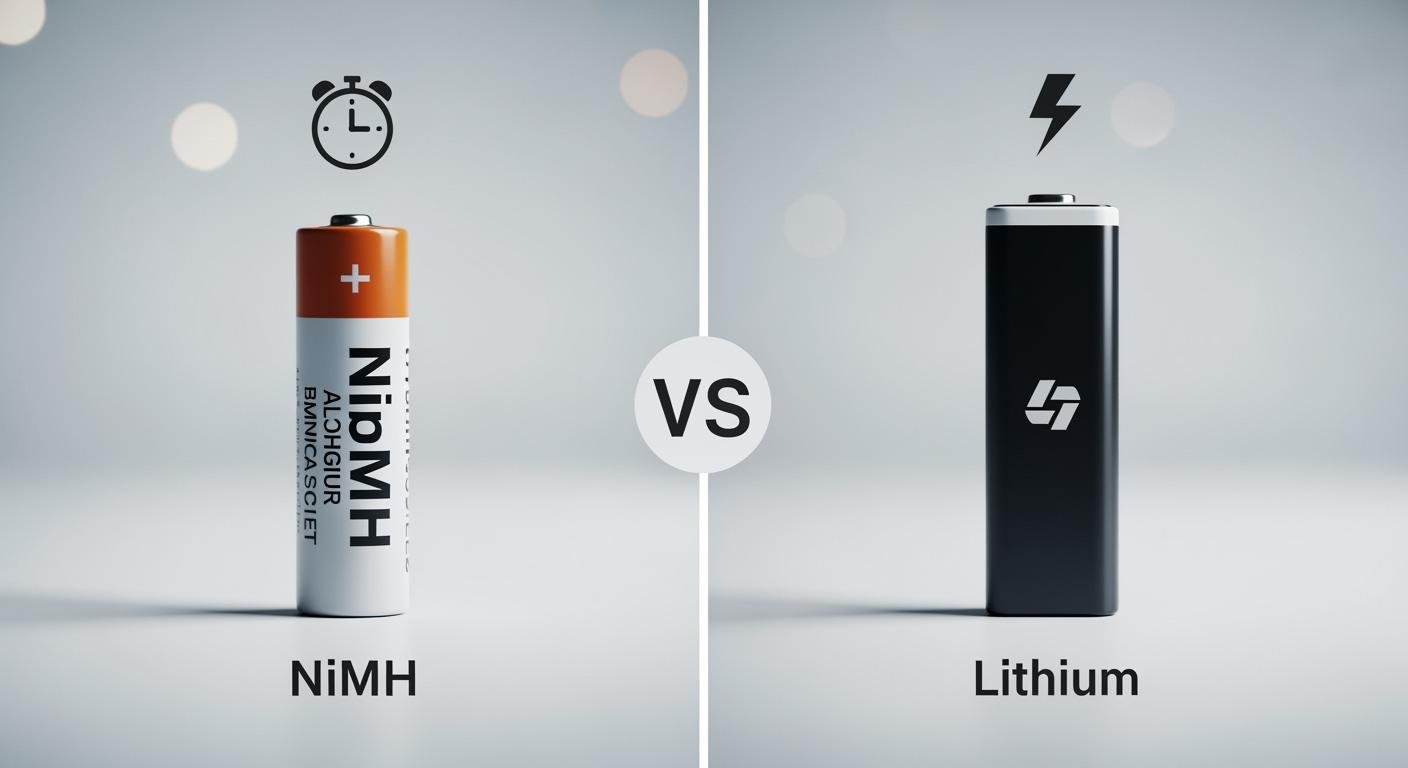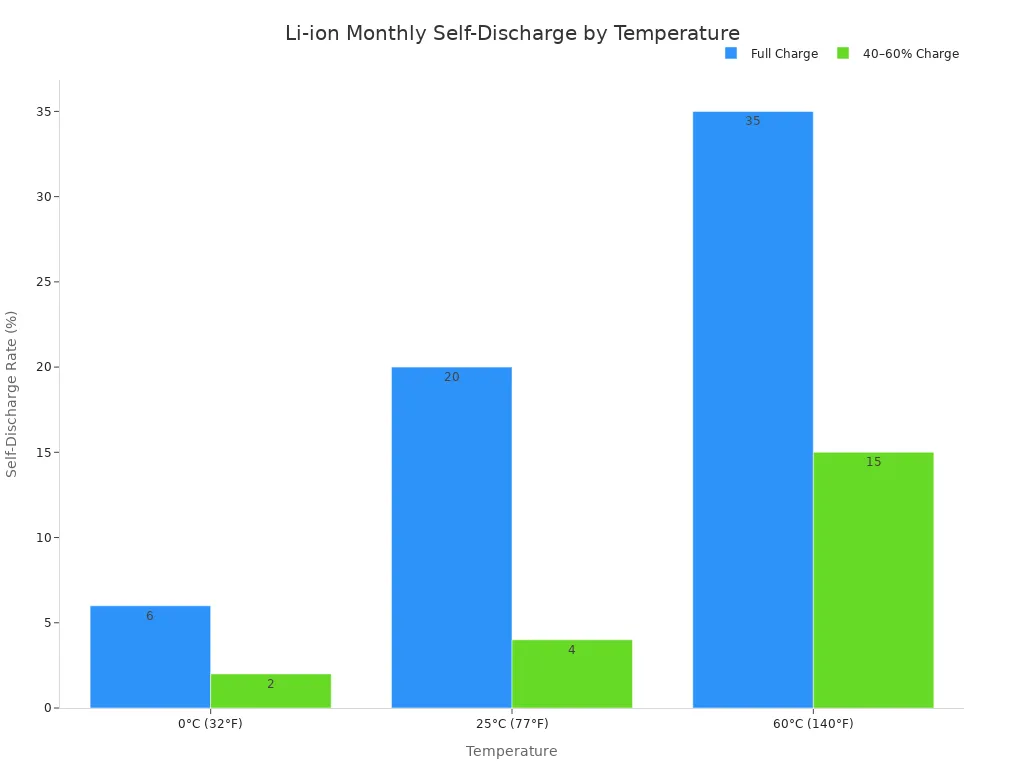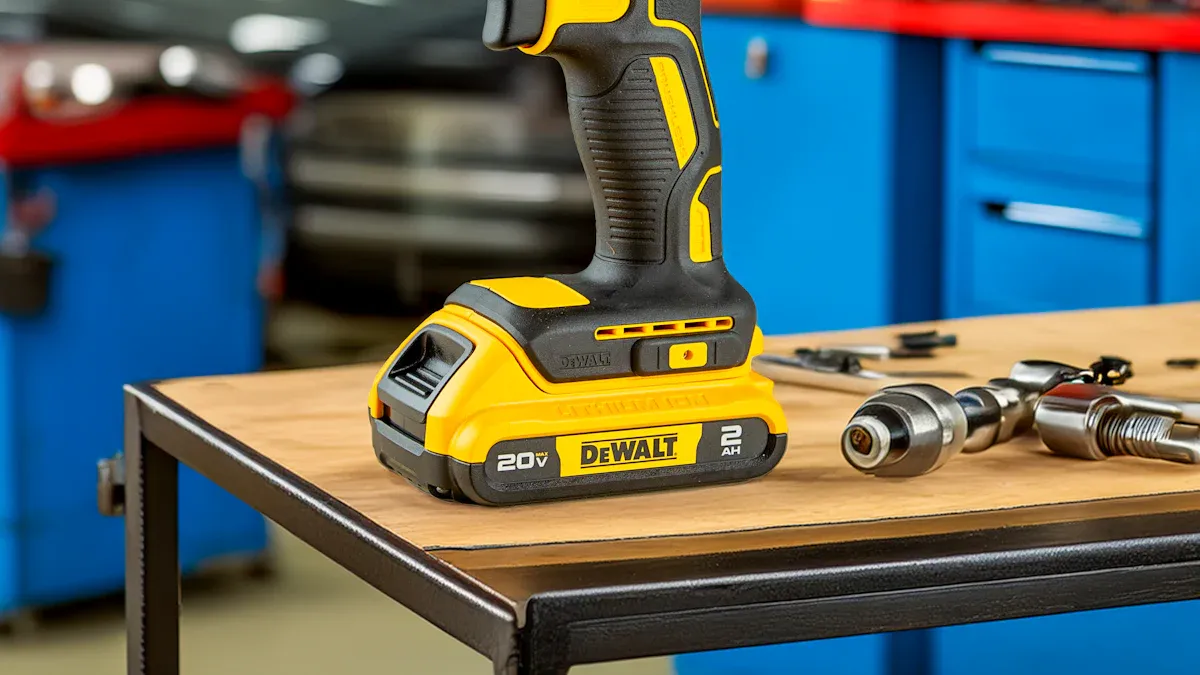
Lithium-ion batteries generally offer a superior lifespan and performance over NiMH batteries. The nimh vs lithium batteries comparison reveals the key differences between li-ion and nimh batteries. This battery technology directly impacts battery performance and energy output for various applications. A lithium battery often has a higher energy density, while a NiMH battery may have a lower initial cost. This affects the overall battery life.
| Metric | NiMH Batteries | Lithium-ion Batteries |
|---|---|---|
| Cycle Life | 300–500 cycles | 1,000+ cycles |
| Self-Discharge | High (20-30%/month) | Low (1-3%/month) |
| Energy Density | Lower | Higher |
| Voltage | 1.2V per cell | 3.6V per cell |
Lifespan Comparison: NiMH vs Lithium Batteries

A battery’s lifespan is more than just how long it lasts on a single charge. It involves its total number of charge cycles, how well it holds a charge over time, and its overall durability. The nimh vs lithium batteries debate often centers on these long-term performance metrics. Lithium-ion batteries generally have a longer and more robust lifespan compared to NiMH batteries.
Cycle Life and Longevity
Cycle life measures how many times a battery can be fully charged and discharged before its capacity drops significantly. This is a critical factor for the long-term value and usability of rechargeable batteries.
- NiMH Batteries: Standard NiMH batteries typically offer a shorter lifespan, lasting between 300 and 500 cycles. This means they wear out faster and require more frequent replacements in devices that are used and recharged often. The performance of a NiMH battery degrades more quickly over its lifespan.
- Lithium-ion Batteries: In contrast, lithium-ion batteries provide a much longer lifespan. They can endure 1,000 or more charge cycles. This superior longevity makes them a better investment for high-use applications.
💡 Did You Know? The way you discharge a battery affects its lifespan. A lower Depth of Discharge (DoD), which means not fully draining the battery, can dramatically increase the cycle life of lithium-ion batteries. For example, only discharging a lithium battery to 60% can more than double its expected lifespan.
The table below shows how DoD impacts the cycle life of two common types of lithium-ion batteries.
| Depth of Discharge (DoD) | Approximate Cycle Life (NMC) | Approximate Cycle Life (LFP) |
|---|---|---|
| 100% DoD | ~300 cycles | ~600 cycles |
| 80% DoD | ~400 cycles | ~900 cycles |
| 60% DoD | ~600 cycles | ~1,500 cycles |
| 40% DoD | ~1,000 cycles | ~3,000 cycles |
| 20% DoD | ~2,000 cycles | ~9,000 cycles |
| 10% DoD | ~6,000 cycles | ~15,000 cycles |
Self-Discharge and Charge Retention
Self-discharge is the tendency of batteries to lose their charge even when not in use. This is a key area where lithium and NiMH battery technology differ greatly.
NiMH batteries have a very high self-discharge rate. They can lose up to 20-30% of their stored energy in the first month. This makes them a poor choice for devices that sit idle for long periods, such as emergency flashlights or TV remotes. You might find a fully charged NiMH battery nearly empty when you finally need it.
Lithium-ion batteries, on the other hand, have an excellent charge retention. They lose only about 1-3% of their charge per month. This low self-discharge rate ensures that a lithium-ion battery is ready to go when you need it, making it ideal for both high-use and low-use applications.
Temperature also plays a major role in self-discharge for all batteries. Higher temperatures accelerate this process. The rate of discharging can double for every 10°C (18°F) increase in temperature. Storing batteries in a cool, dry place helps preserve their charge and overall battery life.

Calendar Aging and Overall Durability
Beyond cycle life and self-discharge, other factors contribute to a battery’s degradation over time. This is known as calendar aging.
The chemistry of NiMH batteries makes them vulnerable to damage from improper handling.
- Overcharging: Leaving a NiMH battery on a charger for too long can cause permanent damage and reduce its lifespan.
- Deep Discharging: Completely draining a NiMH battery can also shorten its life. Draining it just a little too far can significantly cut its lifespan.
- High Temperatures: Operating NiMH batteries above 40°C drastically reduces their cycle life.
Lithium-ion batteries also degrade over time, but they are generally more resilient due to their chemistry and built-in protections. The main factors affecting their durability include:
- Calendar Aging: This is a natural process where the battery’s internal components slowly break down. High temperatures accelerate this degradation.
- Improper Usage: While more robust, overcharging or deep discharging still harms a lithium-ion battery. However, most modern lithium-ion batteries include a Battery Management System (BMS). This smart circuit protects the battery from overcharging, deep discharging, and overheating, which greatly enhances its lifespan and safety.
- Physical Damage: Any physical damage can cause rapid failure and create safety concerns for lithium-ion batteries.
Overall, the advanced battery technology in lithium-ion batteries gives them superior durability and a longer functional lifespan compared to NiMH batteries, especially when considering real-world use and potential for user error. The higher initial cost of a lithium battery often pays off through better performance and a longer lifespan.
Power and Performance Analysis
Power and performance are where the differences between NiMH and lithium-ion batteries become most apparent. A battery’s ability to deliver consistent energy, its weight, and how it is charged all contribute to its overall performance. The nimh vs lithium batteries comparison shows that lithium technology generally provides superior power characteristics for demanding applications.
Energy Density and Weight
Energy density measures how much energy a battery can store for its size or weight. A higher energy density means a battery can be smaller and lighter while providing the same amount of power. This is a critical factor for portable electronics.
Lithium-ion batteries have a significant advantage in energy density.
- Lithium-ion Batteries: These batteries typically offer an energy density between 150 and 250 Watt-hours per kilogram (Wh/kg). This high density allows them to pack a lot of power into a small, lightweight package.
- NiMH Batteries: In contrast, NiMH batteries have a lower energy density. Their energy density usually ranges from 60 to 120 Wh/kg. For example, a cylindrical NiMH battery might have an energy density of around 80 Wh/kg.
This difference has a direct impact on device design and usability. For an equivalent amount of energy, a NiMH battery pack is much heavier and bulkier than a lithium-ion battery pack. A lithium battery can be three times more energy-dense by weight, making it the clear choice for devices where portability is key, such as smartphones, drones, and laptops.
Voltage Stability and Power Output
Voltage determines the power a battery can deliver to a device. Higher and more stable voltage translates to better and more consistent performance.
The nominal voltage per cell shows a major difference between the two chemistries.
- A NiMH cell provides about 1.2 volts.
- A lithium cell provides about 3.6 volts, three times that of NiMH.
This means fewer lithium cells are needed to achieve a desired voltage, which further reduces battery pack size and weight. More importantly, lithium-ion batteries maintain their voltage level throughout the discharge cycle. They have a flat discharge curve, providing steady power until the battery is nearly empty. This ensures consistent device performance.
NiMH batteries, however, experience a more gradual voltage drop as they discharge. This can cause devices to slow down or function poorly as the battery drains. The less stable voltage of a NiMH battery can lead to unpredictable performance, especially under high load. The superior voltage stability of lithium-ion batteries ensures optimal functionality for high-drain applications.
Charging and Maintaining the Batteries
Charging protocols and maintenance needs are very different for NiMH and lithium-ion batteries, affecting their convenience and long-term lifespan.
Charging NiMH Batteries Charging NiMH batteries can be complex. They are sensitive to overcharging, which can cause permanent damage and reduce their lifespan.
- Slow Charging: A slow overnight charge is often safest but can take 13-15 hours.
- Fast Charging: Faster charging is possible but requires a smart charger that can detect when the battery is full by monitoring temperature changes. Without this, there is a risk of overheating.
- Trickle Charging: A low-level trickle charge can keep NiMH batteries topped up, but it must be carefully managed to avoid damage.
Maintaining NiMH Batteries NiMH batteries suffer from a “memory effect.” If you repeatedly recharge a NiMH battery after only partially discharging it, the battery “forgets” its full capacity. It starts to act as if the smaller capacity is its new maximum. To prevent this, users should periodically perform a full discharge cycle. This maintenance adds a layer of complexity for the user.
💡 Tip for NiMH Users: To combat the memory effect, fully discharge your NiMH batteries once every few months before recharging them. This helps restore their full capacity and extends their usable life.
Charging and Maintaining Lithium-ion Batteries Lithium-ion batteries are much easier to manage. They do not have a memory effect, so you can charge them at any time without worrying about reducing their capacity.
- Charging Process: A standard charge for a lithium-ion battery typically takes 2-4 hours. Most modern lithium-ion batteries include a built-in Battery Management System (BMS). This circuit provides critical safety by preventing overcharging, deep discharging, and overheating.
- Best Practices: For optimal battery health, it is best to keep lithium-ion batteries charged between 20% and 80%. Avoiding full charge-discharge cycles can significantly increase their lifespan. Storing them at around 50% charge in a cool place is ideal for long-term storage.
The advanced battery technology in lithium-ion batteries simplifies charging and maintenance, offering better battery performance with less user effort. This convenience, combined with their superior energy density and power output, makes them a preferred choice for most modern electronics.
Pros and Cons of Li-ion vs. NiMH Batteries
Choosing between these two battery types involves weighing the pros and cons of li-ion vs. nimh batteries. Key factors include cost, safety, and environmental impact. Each battery chemistry presents a unique set of advantages and disadvantages for different applications.
Cost and Affordability
Cost is a major factor in the nimh vs lithium batteries debate. NiMH batteries generally have a lower upfront purchase price. This makes them an attractive option for users on a tight budget.
However, the long-term cost tells a different story. The manufacturing cost for lithium-ion batteries has fallen dramatically. Over the past decade, production costs saw an 85% reduction. While the initial cost of a lithium-ion battery is higher, its longer lifespan means fewer replacements over time. This often makes the lithium battery a more economical choice in the long run. The higher energy density of lithium-ion batteries also means you get more power for the price. The overall cost of ownership for lithium technology continues to improve.
Safety Considerations
Both battery types have safety concerns that users should understand.
NiMH Batteries NiMH batteries are generally considered very safe. However, improper use can lead to problems.
- Overcharging or using damaged NiMH batteries can cause them to leak a corrosive alkaline fluid.
- A blocked gas vent on a NiMH battery can cause it to burst under pressure.
- Connecting NiMH batteries with reversed terminals can cause leakage and heat generation.
Lithium-ion Batteries The primary safety risk for lithium-ion batteries is thermal runaway. This is an uncontrolled heating process that can lead to fire or explosion. It is often triggered by physical damage or overcharging.
🛡️ Built-in Protection: Modern lithium-ion batteries include advanced safety features. A Battery Management System (BMS) prevents overcharging and overheating. Internal devices like safety vents and circuit interrupters provide extra layers of protection, making these batteries very safe for everyday use.
Environmental Impact
The environmental pros and cons of li-ion vs. nimh batteries are complex. NiMH batteries are often seen as a greener option. They contain no toxic heavy metals. The main concern is ensuring these NiMH batteries are recycled to recover valuable materials like nickel.
Lithium-ion batteries present different challenges. The mining of raw materials like lithium and cobalt can cause habitat destruction and water pollution. Producing the materials for a lithium-ion battery is an energy-intensive process. However, recycling for both NiMH and lithium batteries is improving. While a myth once claimed only 5% of lithium-ion batteries were recycled, actual collection rates are higher and growing. Proper recycling of all batteries is key to reducing their environmental footprint.
Key Differences Between Li-ion and NiMH Batteries: Practical Applications

The key differences between li-ion and nimh batteries determine their best application scenarios. A battery’s chemistry directly impacts its performance in various devices. Understanding these differences helps users choose the right power source for their specific needs, from high-power portable electronics to simple household gadgets.
High-Drain Device Applications
High-drain devices demand a lot of power quickly. The nimh vs lithium batteries comparison clearly favors lithium for these applications. Lithium-ion batteries are the top choice for modern portable electronics. Their superior usability in high-drain devices comes from several key advantages.
- High Energy Density: Lithium-ion batteries pack more energy into a smaller, lighter package. This allows devices like smartphones and laptops to run longer.
- Fast Charging: These batteries recharge quickly, minimizing downtime for users.
- Stable Power: A lithium battery provides consistent voltage for better device performance.
These features make lithium-ion batteries ideal for power tools, drones, and hybrid electric vehicles. While lithium dominates, some NiMH batteries remain useful. Common uses for NiMH batteries in high-drain applications include remote-controlled cars and gaming controllers, where their lower cost is an advantage. The excellent usability in high-drain devices makes the higher initial cost of a lithium-ion battery a worthwhile investment for most demanding applications.
Low-Drain and Household Applications
For devices that use little power over a long time, the choice of battery is different. NiMH batteries are an excellent and affordable option for many household applications. While standard NiMH batteries have high self-discharge, a special type solves this problem.
💡 A Better NiMH Battery: Low Self-Discharge (LSD) NiMH batteries, also called ‘pre-charged’ or ‘hybrid’ batteries, hold their charge for much longer. They can retain up to 85% of their energy after a year in storage.
This makes LSD NiMH batteries perfect for low-drain applications. Common uses for li-ion batteries are not typical here due to their higher cost. Instead, NiMH batteries power devices like:
- TV remotes
- Wall clocks
- Wireless mice
- Emergency flashlights
These application scenarios do not require the high performance of lithium-ion batteries. The reliability and lower cost of a NiMH battery make it a practical choice. For these applications, the safety and affordability of NiMH batteries are key benefits.
For high-drain applications, lithium-ion batteries are the superior choice. The long lifespan and high energy density of a lithium battery make these lithium-ion batteries ideal. A lithium-ion battery provides excellent energy. NiMH batteries remain a viable option where initial cost is a concern. The safety of NiMH batteries makes these NiMH batteries a practical choice. The nimh battery is reliable. The lithium battery is advanced. These lithium-ion batteries power many devices. The nimh battery is a good battery. The lithium battery is a powerful battery.
Final Recommendation Choose the right battery for your needs:
- Choose Lithium: For high-power applications like smartphones and power tools, the performance of lithium-ion batteries is unmatched. These lithium-ion batteries are powerful batteries. The lithium technology in these batteries is advanced.
- Choose NiMH: For household devices like remotes, the nimh battery is a great choice. These nimh batteries are affordable batteries. The nimh technology in these nimh batteries is dependable.
FAQ
Can you use NiMH and lithium-ion batteries together?
No, users should never mix NiMH and lithium-ion batteries. These batteries have different voltages and discharge rates. Mixing the batteries can damage the device. The lithium battery could over-discharge the NiMH battery, creating a safety risk. Always use the same type of batteries in a device.
Which battery is safer, NiMH or lithium?
NiMH batteries are generally safer. The chemistry of NiMH batteries is less volatile. Lithium-ion batteries have a higher energy density, which creates a risk of fire if damaged. However, modern lithium-ion batteries include safety circuits. These protections make the lithium batteries very safe for normal use.
Do NiMH batteries require a special charger?
Yes, NiMH batteries need a specific charger. A smart charger for NiMH batteries prevents overcharging. Using a charger designed for a lithium battery can damage NiMH batteries. A lithium charger will not detect when the NiMH battery is full. This can cause the batteries to overheat.
Why do lithium-ion batteries cost more than NiMH batteries?
Lithium-ion batteries use more expensive raw materials like lithium and cobalt. The manufacturing process for lithium-ion batteries is also more complex. While the cost of lithium is falling, the advanced technology in these batteries keeps their price higher than that of NiMH batteries.

